The role of the Church | Parish churches | Chantries | Other religious institutions | Heresy | Charitable attitudes | Hospitals | Religious attitudes | Further reading
| RELIGION | ||
|
INTRODUCTORY ESSAY
The role of the Church | Parish churches | Chantries | Other religious institutions | Heresy | Charitable attitudes | Hospitals | Religious attitudes | Further reading |
||
It is tempting today to think of towns primarily as business and industrial centres. Yet by contrast with the secularized and highly commercialized society of the latter half of the twentieth century, in which the cityscape has been dominated by sprawling factories, indoor shopping centres, and towering high-rises for residential, business or governmental use, the urban skyline of the Middle Ages spoke of the prominent role of the Church in society. Those wandering about in towns (particularly the larger ones) or their suburbs must have found it hard not to encounter visual or aural reminders of the presence of God. The towers and spires of cathedrals, abbeys, friaries, and parish churches rose above other architectural features of the townscape (castles excepted). Ecclesiastical precincts incorporated residential and administrative buildings and were encompassed by boundary markers or high walls. Pedestrians might pass by hospitals and maisons dieu (small homes for a handful of deserving poor selected by the founder), leper-houses, schools, bridge chapels, market crosses, and wayside shrines. Institutions operated by the Church consumed a large amount of urban territory, both in their own precincts which were sometimes quite extensive, and in properties they had acquired, by purchase, gift or bequest, which provided revenues from rents. They had command of large proportion of the wealth of the nation. A sizeable minority of the residents of urban areas, whether intra-mural or suburban, were in religious orders: clerks, priests, deacons, monks, friars. Despite the programmes operated by fraternal societies of laymen and laywomen, most of what we would consider today social services were provided by religious institutions: temporary housing and food handouts for the poor or disabled, care of the sick, education, protective custody (sanctuary), and retirement homes. Finally, most of what we know of the Middle Ages through its documentary evidence was written by men trained and educated by the Church.
The Church played an important role in the survival or revival of urban life in the Early Middle Ages, providing some degree of leadership, protection, and a wealthy clientele for local products and services; the growth of many settlements was initiated or stimulated by the foundation of cathedrals and monasteries. This patronage and authority continued in subsequent centuries. In the High Middle Ages, bishops were prominent among the founders of "new towns". Even where bishops or abbots were not themselves lords of towns, their influence was strong: they had jurisdiction over large areas within the urban boundaries, they were employers or landlords of many townspeople, and they exercised spiritual authority. The more important of these ecclesiastical foundations demonstrated their dominance in the form of superior skills (e.g. architectural, literacy), through the wealth at their disposal, and through the favour of king and nobles, who were patrons of the institutions and increasingly chose burial there.
On the other hand, the proliferation of smaller churches during the High Middle Ages, of which Domesday Book provides clear evidence, can also be an important reflection of urban development, since these churches were largely private foundations and the result of a growth in prosperity in urban areas. During the Early Middle Ages the Christian church had a missionary character in England, and the minsters built as a focus of missionary activity were the central points of worship, in part because there were relatively few priests available. However, it was more suitable to many of the converted owners of estates to build their own chapels or village churches, and at the same time the very centralization of the minsters made them targets for the depredations of the Vikings.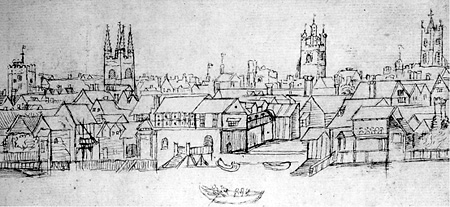 |
|
These illustrations of London suggest how ecclesiastical architecture
visually dominated the cityscape. (Above:) Extract from a panorama of the London waterfront, in the western half of the city just east of St. Paul's, viewed from the Thames; from an anonymous sketch ca.1550 now in the Ashmolean Museum. (Below:) The Greyfriars hall dominates the northwest corner of the city near Newgate, where Joce fitz Peter, a former sheriff, whose son subsequently became a friar, donated land for the friary ca.1226, while alderman Henry de Frowyk assisted the friars in building an aqueduct to supply the friary with clean water; extract from Ralph Agas' plan of London, ca.1560/70. |
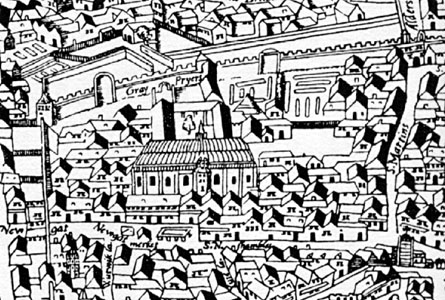 |
The tenth and eleventh centuries saw a high-level of church-building by laymen in established towns; it was an activity by which men showed that they were men of wealth and status, leaders in their community, and to be respected for their piety. Although these churches were mostly associated with private residences, some public use may have been allowed, if only for the founder's tenants. The transfers of land ownership after the Conquest added further impetus to church-building or to re-dedications of existing churches. At the same time as local churches were proliferating, the tithe system enforced by legislation in the tenth century provided a means for their financial support and, by placing the onus of support on the locality rather than the private founder, set the scene for the gradual development of the parish system.
By the twelfth century, during which period the nobility turned over their control of many local churches to the bishops or to monastic houses, the parish system had taken shape and private churches were being converted to parish churches. The number of churches reached its peak around this time or a little later, in part due to development of new towns or expansion of existing ones. The number actually declined slightly during the Late Middle Ages, and new towns founded from the twelfth century on were more likely to focus on a single parish church. Urban wealth in this period focused rather on the rebuilding, expansion and beautification of parish churches (although this did not happen in all towns), and private citizens had to content themselves with founding chantries or chapels rather than entire new churches. But their investment in churches enabled adaptation of facilities to changes in religious doctrines and attitudes so that the sacraments could be administered in ways better meeting the needs of the community; patronage of friaries and hospitals was similarly motivated by spiritual and materials needs of the patrons and their fellow townspeople.
The high ratio of churches in medieval Norwich is still evidenced by surviving buildings, although many have now been turned to non-religious uses. As astonishing as this concentration may seem to the modern visitor, around 1300 there were almost twice as many: perhaps 60 parish churches, serving a city population probably between five to ten thousand people. Although the Late Middle Ages saw a drop in the number of churches at Norwich, some destroyed and others reduced to chapels, most of those that remained were rebuilt on a larger scale and were capable of holding congregations of around 200-250. London had just over twice as many churches as Norwich, but serving a population several times the size; the Great Fire of 1666 put paid to most of the medieval structures. The number in York, compared to population size, again suggests an average congregation of about 200 people. It was the longer-established towns that had so many parishes, inheriting a network of churches established prior to Domesday. By contrast, less important towns such as Maldon had only a few parishes, while the newer foundations of Lynn and Yarmouth are examples of the single-parish model.
Early churches were mostly modest in size and simple in plan. Their primary role was to accommodate a congregation, and so the most basic form of a church encompassed a single rectangular hall. A second important function was liturgical services, and so the most common form of the early church involved two adjoined spaces: nave and chancel. Some churches were built with, or had added later, side chapels for special ceremonies (e.g. funerals) or to house altars to saints other than the principal dedication. Or they might have a tower to serve as belfry, community landmark acting as a constant visual reminder of Christian values – many of the Anglo-Saxon towers probably having been crowned by a wooden steeple – and for defensive purposes (although this aspect has been exaggerated). Anglo-Saxon churches used much more timber in their construction than we see today; the rebuilding that became fashionable in the twelfth century, and continued into the thirteenth, replaced timber structures with more durable stone.
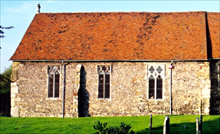 |
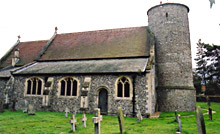 |
|
Early churches, (left) St. Mildred's at Canterbury, and (right)
St. Mary's at Burnham Deepdale. (click on the images for enlarged versions and more information) |
|
That trend was accompanied by the elaboration of church decoration through wall-paintings and followed by the introduction of stained glass. The Biblical stories and miracles portrayed were intended to assist preachers with the instruction of the laity in religious messages; initially they illustrated Biblical stories and figures, particularly the life of Christ, but towards the close of the Middle Ages more admonitory themes – such as the Last Judgement or moralistic stories – were favoured, a change in temperament inspired partly by the traumatic impact of the Black Death. But there was also a desire simply to beautify churches for the glory of God (and to win divine favour for those who paid for the beautification), seen in the more elaborate carving on fonts, the intricate wooden screens to separate one section of the church from the remainder, and the ornate tomb sculptures that began to find their way inside churches from the thirteenth century, followed by brasses. By the fourteenth century we see an almost competitive interest on the part of laymen for contributing towards the improvement and decoration of the fabric of the church and and beauty and richness of its furnishings; most leading townsmen in their wills left something to their parish church, if not to several churches in their community as well as to those in places with which they had family or commercial connections, although part of the rationale was self-interested piety.
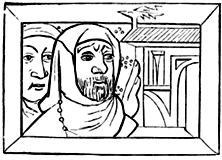 |
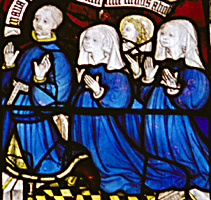 |
|
Townspeople could give generously to the Church in life as well as in
death. Besides genuine piety, they were motivated by such things as
the desire to beautify the parish churches where they worshipped,
to enhance their social status by being seen as benefactors, and
to obtain some benefit in return from the Church – such as prayers
for the soul, or retirement
provisions. (click on the images for enlarged versions and more information) |
|
The parish was the principal means of organizing the practice of religion by the lay community. Parishioners were expected to attend mass in their parish church each Sunday and on the special festivals, to receive the sacraments of Penance and the Eucharist there yearly, and to support the parish church through tithes and oblations (offerings). The roles of the parish priest were:
The principal income to support the parish church and its staff was the tithes, a kind of tax payable on crops, livestock, wage earnings, and profits from commerce or industry. The Church was constantly battling with a minority of parishioners to obtain these payments due it; but the majority seem to have acquiesced in their financial obligations, although resentment over tithes seems to have increased in the fourteenth and fifteenth centuries, perhaps most notably in London where resistance became widespread. In those later centuries, wills not uncommonly include bequests to the parish church to cover tithes unpaid due to (supposedly) negligence or oversight, although the small size of most such bequests is not suggestive of serious defaults. A mortuary payment at the funeral was expected, in part to cover defaults in tithes. Ad hoc offerings, at festivals or in gratitude for non-routine services also contributed to the income supporting the church, the maintenance of the priest in his own residence, and the payment of those who helped the parish priest undertake increasingly complex liturgical and administrative duties – notably a parish clerk, sometimes with his own assistant (the suffragan).
With much of the responsibility for the upkeep and improvement of church buildings falling upon the parish community, meetings of parishioners – later to become formalized as the vestry – must have occurred periodically, and we start to hear in the late thirteenth century of the churchwardens, lay officers whose range of duties, growing over time, included fund-raising, repair of church fabric and furnishings, purchase of supplies, and adminstering some of the church revenues. However, this kind of community involvement in managing church affairs may have varied from place to place across the country; the scarcity of related documents leaves us uncertain how common churchwardens were. For the extensive improvements or substantial re-building efforts undertaken in the late fourteenth and fifteenth centuries, individual benefactors vying with each other in their generosity were instrumental in some initiatives, while the cumulative effect of small gifts or communal collections financed others; on one level, these alterations were aimed in part at making church conditions (e.g. lighting) better for the congregation, on another at memorializing the benefactors. The focus of the parish community on the physical fabric of its church, with the setting up of fabric funds and testamentary bequests to the fabric, provided another factor that siphoned money away from payment of tithes, perceived as supporting priests rather than churches. The connection felt by at least the elite parishioners to their churches may have been further strengthened by the use of some, in a number of towns, for meetings of the borough court and/or council. Sometimes this may have been just a matter of lack of space in any secular buildings, until purpose-built halls were constructed for such functions. But the solemnity of churches may also have influenced the choice, and it perhaps seemed appropriate for functions closely involving the exercise of the cardinal virtues of prudence and justice to take place in the house of God, where there would have been visual reminders of the need for civic rulers to perform virtuously.
Not only the parish community but also craft gilds and socio-religious gilds had associations with some particular church, or a chapel within a church. Gild valuables or trappings for pageants might be stored there. Gilds or individual members were among the patrons of improvements to those churches, whether extensions to or renovations of the structure, or beautification the church. The last century of so of the Middle Ages saw increased decoration of tombs with three-dimensional effigies or brasses; equipping of churches with gifts of relics or jewelled ornaments, religious art, gold and silver plate, service books, and even decorative priestly vestments; introduction of more carved features, such as roof supporters, pew ends, pulpits, and reredos; and, with rebuilding introducing more and larger windows, more numerous installations of painted glass (largely destroyed during the Reformation). In the case of the last, donors were often acknowledged by including in one of the less central panels their arms, a portrayal of them at prayer, or some representation of their trade. Brasses were likewise an expensive decoration; they reflect a growing preference for burial inside a church – something restricted to ecclesiastics until the twefth century, and still uncommon in the next except for the nobility. To obtain this privilege, bequests to the church were de rigueur.
While the beautification of parish churches was in part a matter of community and of civic pride, the desire of the wealthy to leave a memorial for themselves and the more general desire to commemorate their dead and, particularly, provide for the well-being of their souls during the expected ordeal in Purgatory. Borough governments increasingly became involved in the administration of such matters, as citizens looked to them – as perpetual institutions – to manage and protect their pious investments. The piety of the corporation itself (whether real or to enhance its authority) often found expression in the fifteenth century through a close affiliation with a socio-religious fraternity.
Chantries were endowments to maintain one or more priests to celebrate services for the soul of the founder(s), typically on a daily basis; foundations might take place during the founder's lifetime or through testamentary provision. Some founders intended for these services to continue indefinitely, and so we refer to them as perpetual chantries, in contrast with the provision of services for a limited period – usually for one year or a few years following death – which can be considered temporary chantries. The foundation of chantries was one of the most common concrete forms in which piety was expressed in late medieval England. In that period it was believed that nothing so pleased God as to have mass celebrated, and so to provide for the saying of mass was a sure way of winning divine favour. There are many instances, therefore, of medieval townspeople providing during life or at their deaths for masses being said. Money might be given to an existing religious institution so that one or more of its members would provide this service, or property assigned to provide annual income to support the services. In the latter case, those who could afford it established independent chantries through which masses could be said daily on a permanent basis, with a priest appointed solely for that function – wealthier founders, such as Richard Whittington, might set up a college of priests to man the effort.
If the founder was particularly wealthy, a perpetual chantry might have its own dedicated building constructed, served by a college of priests, or a new chapel built onto an existing church. But more commonly chantries were established in existing chapels of churches, or in other parts of the church, usually with a new altar being provided for the purpose by the founder; alternatively, services might be said at the tomb of the founder. It is important to conceive of chantries as services rather than places.
During the Late Middle Ages it was not too difficult to obtain licence to found a chapel in which a chantry was established. Those wills that have survived for citizens of fourteenth-century London show that an average of 28 chantries were founded each decade. At York we know of at least 140 perpetual chantries that were founded during the course of the Late Middle Ages. Not all of the urban chantries were founded by citizens, whether individually or communally through gilds; some were by clerics or by gentry residing outside the town. However, all too often the funding provided for the indefinite continuance of chantries – usually in the form of a real estate endowment, whose annual rents supported chantry costs – proved inadequate within a couple of generations, or for other reasons the chantry lapsed or was amalgamated with a later foundation. The problem lay partly with dropping property values, and partly with rising clerical wages, following the depopulation due to mid-fourteenth century plague. Those able to provide a higher-level income to ensure continuance (like John Baret) had similarly high expectations of the amount of work the chantry priests would undertake. Others with more modest means, or more realistic outlooks, might provide for services to be said for their souls for a finite period of years; in fifteenth-century York, experiencing economic decline, this became the norm and foundation of perpetual chantries became a rarity. Still others might place their reliance on membership of socio-religious gilds, part of whose function was to maintain services for the souls of deceased members.
The vigour and importance of a medieval town may be reflected in the number of foundations not only of parish churches but of other religious institutions such as monasteries, friaries, hospitals – particularly the latter two, which were more reliant on support and donations from townspeople – and in a few cases cathedrals. Towns were less reliant than were rural communities on the parish church to provide the range of religious services needed. A few of the wealthiest townspeople could even afford to employ private chaplains or have private chapels in their own homes, although the extent of this practice seems to have varied from town to town.
The larger religious foundations – monasteries and abbeys, predominantly Benedictine, Cistercian or Augustinian – tended to have a touchy relationship with the urban community within, or adjacent to, which they were situated. Initially trying to distance themselves from from the secular world, they attracted benefactors from that world – who endowed them with treasures, lands, and parish churches – and became wealthy and worldly as a result. Although an important market for products and services of the townspeople, the religious houses, as major landlords in the locality, had a degree of legal and commercial jurisdiction that periodically brought them into conflict with urban authorities. Not surprising then that their precincts were surrounded with high, sturdy walls (e.g. St. Mary's Abbey at York).
The friars, on the other hand, were an essentially urban phenomenon from the beginning, since their aim was to minister to sinners rather than to pursue a life of contemplation and worship; they integrated more comfortably, and intentionally, into towns. They arrived in England in the 1220s and, their intent being to preach to the maximum number of people possible, spread from town to town quite quickly during the first half of the thirteenth century; patronage from the nobility was often instrumental in the construction of the earliest friaries. Friaries tended to be built initially on unoccupied, out-of-the-way land, whether inside or outside the walled area of a town, that was of little use for other purposes. But in the fourteenth century we find some trying to establish themselves closer to the centre of town life, closer to their audiences. The orders of the Dominicans (Black Friars or Friars Preacher) and Franciscans (Grey Friars or Friars Minor) were most in evidence, with the Carmelites (White Friars) and Augustinians next in prominence.
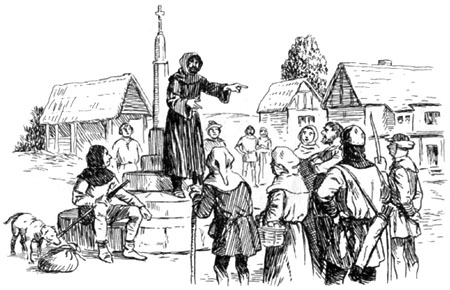
Twentieth-century depiction of a friar preaching
from what may be intended to depict a market cross
although there did exist special
preaching
crosses. Part of the initial success of the friars was due to the fact
that they sought out audiences in mundane, even profane, places, rather than
building churches to which townspeople were obliged to come to hear the Word of God.
It was, ironically, the fact that friars were dedicated to lives of poverty that attracted the approval of townspeople (as well as of the nobility) and their benefactions. Historians are uncertain whether this endeared them to the lowest levels of urban society: the ideal of apostolic poverty, in the context of a community of mutual support, may not have had much appeal to those living in destitution and lacking the communal support available in the upper echelons of urban society. On the other hand, perhaps the friars' philosophy that poverty was a commendable state which would bring rewards in the afterlife enabled prosperous townspeople to feel less concerned about the plight of the poor. Yet a high level of patronage could work against the friars; if they became seduced away from their ideals by the higher standard of living made possible, it could jeopardise their reputation in the eyes of townspeople. That the friaries must have been comparatively comfortable accommodations is suggested by the fact that visiting dignitaries, including kings, often chose to stay there.
Friaries attracted not only living benefactors and guests, but also dead ones. Donations to friaries are a common feature of wills, and they were popular burial places for those who could afford it. Friaries seem to have been attractive to the upper echelons of urban society, which increased the resentment of the parish clergy at the competition. As well, arrangements for memorial services to the deceased could be made through the friaries, as an alternative to a chantry in a parish church. But perhaps their greatest influence on urban society may have been through their sermons, although we know too little about these to judge precisely what impact they had.
Sizable chunks of urban land had been, by the close of the Middle Ages, consumed in the larger towns by friary precincts; it being the major towns, with the larger populations and wealthier benefactors, where multiple orders could flourish side by side. Some were established within the heavily populated areas of towns, while others received land in less populated or wasteland areas, or in suburbs, although the friars' preference seems to have been to be situated as close to their lay audiences as possible. The management of property may have helped make the friars more worldly, although they sometimes sought lay administrators. The friaries, along with monasteries, were dissolved in the reign of Henry VIII and their properties passed into private hands, a fact that goes a long way to explaining why relatively little has survived either of their architecture – except where it was suitable for conversion to residential or commercial purposes – or their archives.
The thirteenth and fourteenth centuries were a time of great intellectual speculation, thanks in part to the rise of universities, when established theology was subjected to question. There was, however, no significant heretical movement in England before the late fourteenth century. At that time, from the environment of intellectual debate emerged John Wycliffe; his initial metaphysical speculations expanded into a condemnation of the structural fundamentals of the Church: the papacy, the sacraments, priestly authority, excommunication, etc. Although heresies which had divided society in parts of Europe in the twelfth and thirteenth centuries had left England largely untouched, there had been, for a long time before Wycliffe, among the common people and even the lower ranks of the clergy a distaste for the wealthy, self-satisfied, and, in some instances, dissolute Church establishment more interested in protecting the status quo than promoting true Christian values. The worldly vices of some of the clergy, and absenteeism of others, so that duties to parishioners were left to those less well-endowed, similarly diminished laymen's respect for the mainstream Church. This helps explain why the friars, initially exemplars of the ideals of apostolic poverty, simplicity and spirituality (and, ironically, a rather anti-establishment movement given papal blessing in order to fight heretical fire with fire), were welcomed by townspeople as an alternative. Wycliffism only added doctrinal enrichment to an existing undercurrent of religious thought that, in later times, is called puritanical.
It was not heresy but plague that brought disruption to social organization, both secular and religious, prompting the lower classes (now at an advantage with the shortage of labour) to seek economic improvement while increasing their resentment of the wealthy, while landlords tried to dig in their heels and maintain the established social and economic order. Wycliffism, arising at a time when even the friars had lost their apostolic ardour and become propertied and worldly and a target for criticism, simply gave the underlying discontent a focus and brought anti-clericalism to a crisis point, of which one expression was the Peasants' Revolt, with its insistence on redistribution of the wealth of the Church. Its initial successes were also due in part to the preparedness of some politicians – as far up the ladder as John of Gaunt – to support anti-clericalism for their own reasons.
The heretical movement called Lollardy (originally by its detractors, although the precise meaning of the term is debated), following in Wycliffe's footsteps, and facilitated to some degree by the political conflict in the latter part of Richard II's reign, acquired sufficient support as to present a real threat to both Church and State, requiring severe measures from each to suppress it. They included an Act promulgated by the Church and supported by the State, condemning persistent heretics to be burnt at the stake – although there were not very many executions, the Church preferring public recantations to martyrs. By 1414, with the failure of the uprising by Sir John Oldcastle – a response to the newly-enthroned Henry V's expressed determination to support his bishops in stamping out heresy – the strength of the movement had been broken. Yet Lollard ideas continued to diffuse through and percolate in various parts of England for the next three decades, and in some places even longer, providing a legacy for Protestantism.
An economic downturn in some parts of England during the fifteenth century aroused among merchants and crafts masters greater resentment towards the wealth of the Church; this may have helped the spread of Lollardy in some towns, while at the same time decreasing tolerance of the licentious behaviour of some of the clergy. The growth in educational standards among the urban upper class may also have been a factor here, both through the spread of vernacular literature and through raising expections of the moral and educational standards of the clergy.

It is not evident that "Lollardy" represents a clearly
defined set of beliefs; confessions of accused heretics suggest
diversity in the ways their beliefs diverged from Catholicism. The above
image of the crucifixion is from a replica of the Jelling runestone in
Jutland, ca.965; the stone was a monument to King Harald Bluetooth's
intent to Christianize the Danes. The original is held by the
National Museum of Denmark.
For I was an hungred, and ye gave me meat: I was thirsty, and ye gave me drink: I was a stranger, and ye took me in: Naked, and ye clothed me: I was sick, and ye visited me: I was in prison, and ye came unto me.
[Matthew 25: 35-36, King James Version]
These instructions of Jesus to his apostles formed the basis of the charitable obligations of Christians in the Middle Ages. They were known as the Corporal Acts of Mercy (that is, compassion) and depictions are found in stained-glass windows such as those at York and Leicester.
In the view of the early Church, private property (i.e. wealth) was not something God had in mind when he created the world and hat desire for wealth inclined people towards avarice and behaviours that were deceitful or usurious. But it was a reality of medieval society and of course the Church itself accumulated immense wealth. The compromise doctrinal position that gradually emerged from the work of theologians and canonists was that while the unbridled pursuit of profit was contrary to Christian morals, wealth was acceptable so long as it was put to good uses, notably the support of one's family and support for the wider community, particularly the less fortunate members of the community. There was no notion of eradicating poverty, as a social undesirable; but alongside an acceptance of poverty as a part of the social hierarchy went the belief that the involuntarily poor had the right to expect help from the wealthy. At the same time, the recognition of poverty as part of the social reality led Catholic thinkers to rationalize and glorify it as a form of spiritual purity, although it is hard to imagine that for the lay poor this made their situation more palatable.
It can be argued – though not without contradiction – that poverty became more of an issue as a result of the emergence and growth of towns. In rural communities, the difference in economic status between one resident and another was less dramatic; most lived close to the subsistence level, but there was a high degree of mutual support possible in a small, close-knit community where everyone knew each other. Towns, by their nature, fostered differentiation in occupation, level of success, and socio-economic status; they attracted large numbers of immigrants, creating a growing labour supply which had an adverse effect on employment availability and wages. The labouring class as a whole was perceived as poor; with no discretionary income, they were also disempowered, and with a poor standard of living and harsh working conditions were more susceptible to health problems. Up to the end of the Middle Ages in England we still find urban society viewing itself through the simple differentiation between the potentiores and the pauperes groups, even though they also saw a middle group in the equation. Thanks in large part to the friars, towns were also where there was a good deal of social pressure, i.e. through preaching, on behalf of poor relief; they were likewise where most charitable support institutions were founded.
The poor, sick, and unfortunate, along with churches and their personnel, were typical recipients of charitable bequests. In some cases it was a matter that the testator believed the intercession of such persons with God, through prayer, would weigh at the final judgement. In others it was a question of relieving the unpleasant circumstances in which those less fortunate found themselves; many prisoners relied on bequests like this to provide them with some income with which they could make their prison conditions less uncomfortable.
It is difficult to judge whether the intentions of such bequests were truly charitable, in the sense that we would understand it, or were more a matter of currying favour with God. By the Late Middle Ages, the fear of Purgatory had become prominent among lay religious beliefs; perhaps particularly in towns, since the friars who especially emphasized this aspect of doctrine. Purgatory was that part of the redemptive process in which sin was purged from the soul of any sinner who had shown penitence before death and had been absolved in the last rites. The purgative process could, it was believed, be eased by investing in charitable and pious acts that both demonstrated contrition and obtained divine intercession through those who had the special favour of God.
We do not have to opt for one or the other motive; they were two parts of a whole. Even in modern charitable works, motivation may combine an easing of the conscience with a genuine desire to help others. Charity was a kind of social contract, a win-win situation. Given strong medieval religious beliefs, most notably in divine judgement and damnation, and the fact that pious and charitable bequests, small or large, were a very common feature of medieval wills, historians today are inclined to emphasize testators' concern for their own souls. Nonetheless, it is also recognized that the last testament provided a final opportunity to give something back to the community – a concept more vital in medieval towns than it is in modern cities – at a time when the testator could have no further personal use for the worldly goods and wealth acquired during life; other than, of course, to provide for heirs, which remained the first priority. Even founding a chantry was more charitable than simply providing for a large but finite volume of masses to be said, for the chantry priests thus employed contributed to the performance of the liturgy of the church as a whole, and to the quality of services for the community.
Nor should we forget the self-satisfaction that comes from giving aid to others. Charity is a value that helps define both personal identity and one's place in society. It is thereby a two-way street. Moreover, a street that links the different strata of society, through mutual obligations. If the wealthy were obliged to provide relief to the poor, the poor were obliged to be grateful and to demonstrate that gratitude in a variety of ways, such as showing humility, not envying their betters or seeking to overthrow them, and interceding with God on behalf of their benefactors, whose advantages in many cases owed something to the transgression of Christian morals; without this return on investment, there might have been far less impetus to charitable behaviour. Charity – as the return of ill-gotten gains to the less fortunate or more exploited members of society – may have enabled the entrepreneurial exploiters to rationalize their good fortune and make it socially more acceptable within a framework of Christian teachings. At the same time, the gradual development of an alternate view of the poor from that of the Church, in which they were perceived as lazy, troublemaking, and sinful, made it easier to think of them as undeserving, and encouraged a narrower focus of charitable efforts towards the close of the Middle Ages. We find many of the charitable institutions set up in the thirteenth or fourteenth centuries having their mandates changed or restricted in the fifteenth, in part due to shifting priorities but as much to a decline in resources, itself the result of factors such as maladministration and decline in public interest.
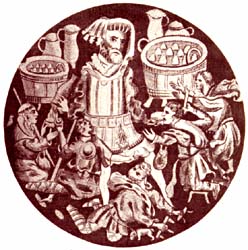
Religious art communicated the importance of
the rich giving to the deserving poor.
(click on the image for an enlarged version and more
information)
From an early time, the Church took some responsibility for creating supportive programmes and institutions for the unfortunate, unprotected, and unaided members of society. The system by which tithes were paid had been created to support poor relief, although this was gradually undermined. It became necessary for laymen to take up the slack, even though only a small percentage of their incomes was diverted to charitable purposes. The foundation of hospitals arose out of a variety of Christian beliefs: the importance of charitable acts (not least for the good of one's soul), concern for the poor and helpless, and support for pilgrimage. It is not clear what proportion of townspeople may have made pilgrimages during their lifetimes, even if only to local shrines; but a small percentage of wills included bequests to individuals to make pilgrimages on behalf of the testator, to fulfill a pilgrimage vow the testator had not personally been able to keep.
The twelfth century saw a growing pace of investment in institutions dedicated to social welfare; these went beyond the provision of hospitality in the guesthouses of abbeys and priories, and show a recognition of the need to address in an organized fashion problems particularly affecting urban society.
Although they were not an exclusively urban institution, hospitals were mostly in towns or just outside them (often on approach roads). This should not be surprising, for several associated reasons:
Early hospitals, as the name indicates, were concerned with providing food and shelter (hospitality) for the needy, continuing the charitable tradition of Benedictine monasteries and nunneries, an ethic which had infiltrated lay society by the late Saxon period. Few hospitals were dedicated to their modern purpose of caring for the infirm and aged and tending to the sick, although there was some growth in that role towards the close of the Middle Ages, with some hospitals becoming essentially retirement homes in which a place could be obtained for a (sometimes fairly substantial) fee. We can distinguish four main types of hospital:
But we should not forget that, as religious houses, hospitals also had the role of worship, the founders looking to set up institutions where prayers for their souls could be said, and worship being seen as curative for the souls of the sick, or preparation for the afterlife on the part of those in the last years of life. Strictly speaking, we should probably see the primary role of medieval hospitals as religious.
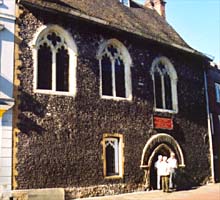 |
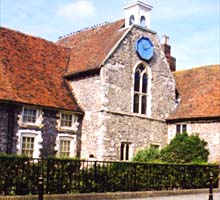 |
|
Two early hospitals in Canterbury, catering to different groups. (click on the images for enlarged versions and more information) |
|
Historians have identified "waves" in which the foundation of hospitals occurred most intensively. The first took place between the middle of the twelfth and the early thirteenth century, and was primarily the initiative of the Church or the aristocracy; by the end of this period there were over 250 hospitals in existence, although many were very modest establishments. A second wave occurred in the late thirteenth century, with townsmen particularly prominent among the founders; there were at least 540 hospitals in existence just before the Black Deaths struck. And another in the fifteenth century, focusing on the almshouse type; these were predominantly urban foundations, occasionally catering to particular groups, such as widows, impoverished members of the ruling class, or the long-term infirm members of specific trades. Following the depopulation and adverse economic effects of the plague in the third quarter of the fourteenth century, hospital funding and governance underwent something of a crisis, some hospitals were unable to stay in operation or were merged with other religious institutions; in some cases, urban governments stepped in to take responsibility for their management.
Most large towns had several hospitals. It was relatively easy for the wealthier townsmen to found and endow small hospitals, and there were no legal restrictions, whereas the endowment of religious houses such as monasteries was more a challenge for the nobility. The locations chosen for hospitals tended to be just outside or inside the town gates (i.e. on routes taken by travellers, who might either be recipients of hospitality, or donors of alms), or on sites that were not in demand or not of use for other purposes, which usually meant they were quieter and there was scope for future expansion; only towards the end of the Middle Ages did such institutions start to appear in significant numbers near the centre of towns. Norwich provides an example of a large town where leper houses were distributed around the outside of the town walls, each near one of the principal gates, thus optimising the prospect of alms from travellers. For the same reason of proximity to traffic, we find a number of hospitals situated adjacent to bridges or quaysides.
Among the most prominent hospitals were St. Leonard's in York, and St. Bartholomew's in London. The latter was one of the earliest founded by a lay commoner, while the former was one of (if not the) wealthiest, housing a large community – about two to three hundred – of clergy, sisters, corrodarians, sick people, and orphans. Excavations of burials on the site of St. Mary Spital, founded just outside Bishopsgate, London, in 1197, have revealed some distinctive groups: a high proportion of adolescents, the hospital being known to have had a special mandate for care of orphans; a group of well-fed, older citizens buried inside the hospital church, reflecting the role of the hospital as a retirement home for the wealthy; and a large number of adult males, possibly representing migrants to London unable to establish themselves and not surviving long.
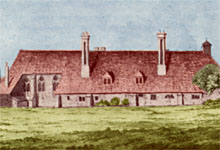 |
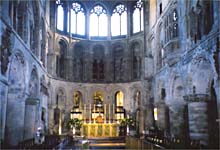 |
|
St. Mary's at Chichester and St. Bartholomew's at London (click on the images for enlarged versions and more information) |
|
As important as the physical fabric of the Church was the set of religious beliefs and attitudes that pervaded urban life. It is not easy for citizens of the highly secularized western world to appreciate how deeply-seated Catholic beliefs were and how they permeated every aspect of medieval life. Matters of individual and public health, for example, were considered so closely tied to moral character that urban authorities seemed impotent to combat the Black Death, since it was seen as a divine judgement, and moral attitudes towards indigent, promiscuous, and leprous members of society hardened while, at the same time, greater emphasis was put on provisions to care for the deserving poor. Inculcation of values and assumptions, behaviour control, and demonstration of the ultimate authority of God, were underlying goals for which the Church employed devices such as bell-ringing (to summon the faithful and to mark the divisions of the day) and the Christian calendar, sermons from the pulpit, artistic imagery within churches, the confessional, judicial jurisdiction over matters of sin, and control of the formal educational system. On the other hand, nor is it easy to reach confident conclusions as to what extent Catholic beliefs and precepts were acted upon upon by all sectors of society, when all we have to go on are reflections. Consequently, historians debate just how sincerely religious were medieval people. It would of course be a mistake to tar all with the same brush, either of unquestioning devotion or scepticism. We find evidence to support both interpretations and must allow for some measure of ambiguity and ambivalence.
There was doubtless a spectrum of religiosity within the urban population, ranging from genuinely devout attitudes (whether catholic or non-conformist) to indifference. There was also some measure of anti-clericalism, fostered by resentment towards the legal privileges and jurisdictional authority of the longer-established religious houses, disgust at the worldliness and even moral corruption occasionally evidenced, but we should not over-emphasize this. The pervasiveness of Christian tenets within medieval society was not just a matter of beliefs, but of established behavioural norms stemming from those tenets; no matter what one's inner beliefs, a certain amount of compliance – sometimes conspicuous compliance – with those norms was advisable for anyone wishing to thrive within a community (and very few could survive independent of any communal support). Nonetheless, urban society accommodated a good deal of diversity in its religious options and a certain amount of leeway in regard to the degree and direction of participation. Those who could afford it, when they made bequests to religious institutions, tended to spread their money among the options: monastic houses, friaries, parish churches, even hermits and anchorites might be recipients. Urban families continued throughout the Late Middle Ages to supply recruits for all branches of the Church, and provided employment opportunities for priests through the socio-religious gilds and chantries they founded and supported.
At the same time, there are indications that the Church was not universally, or at all times, held in the highest respect. Churchyards were often the site for activities that would today seem inappropriate and were occasionally the subject of reproofs in the Middle Ages: commercial transactions were often finalized there; youths played games there, even during services, causing annoyance or worse; and even more formal community sports, such as wrestling matches, might be held there. On the one hand this illustrates how central churches were in community life; however, such activities do not suggest a strong respect for the sanctity of religious sites, and even the time-honoured principle of religious sanctuary was not free from violation. Another indication of less-than-exemplary devotion, suggestive of the priorities of some townspeople, are prohibitions of trading on Sundays or other religious festivals. In relation to this and other distractions, if not a want of religiosity itself, we may note those parishioners who were taken to task before ecclesiastical authorities for their failure to attend divine service and/or pay the tithes or oblations that were expected of them, as well as for performing labour or retailing food or drink on the sabbath. They were a minority certainly, but nonetheless illustrate how strength of religious feeling varied from person to person. A more extreme indifference to divine displeasure is seen in that churches, as a source of items of precious metals and high-quality cloth, were not immune from burglaries. Occasionally, religious houses or high-ranking religious officials were the target for violence; the assault on Norwich cathedral-priory in 1272 and an attack on Bishop Despenser at Lynn in 1377 are extreme but by no means unique examples. In such cases, however, the religious institutions or personnel were resented as possessors of jurisdictional privileges rather than as sources of pastoral authority; yet it was precisely this heavy involvement of the Church in secular affairs that contributed to alienation among the otherwise faithful. Finally, we can point to heresy; this is not an alienation from religion, but as a divergence in belief it further illustrates the diversity in religious attitudes that existed during the Late Middle Ages.
We may suspect that religion was in some regards a privilege of the wealthy. The poorer townspeople, who struggled to make a living, did not always feel they could afford the luxury of a day of worship and rest; it is they we more often find accused of failing to attend church services or pay their dues, and doubtless primarily they who might be driven by desperation to robbing churches. At the same time, wealthier citizens also occasionally bequeathed money to make up for unpaid tithes. There seems to have been some undercurrent of resentment towards the obligatory payments to the Church; although we cannot be certain how widespread it was, the impression is that parishioners preferred to give when charitable feeling moved them, and particularly when they had some say into what was done with the money.
But even here there is uncertainty. To what extent were the wealthier citizens' contributions towards the rebuilding and beautification of churches a genuine expression of religious devotion, and to what extent was it self-serving? Testators who left money to such projects may have been motivated primarily by a last-ditch effort to redeem their souls; their generosity was not necessarily paralleled by comparable patronage during their lifetimes. At the same time, we should not forget that while some parish churches benefited from having wealthy parishioners, other churches were falling into disrepair because parishioners either would not or could not contribute to their upkeep. Possibly financial support for religious institutions varied according to the level of prosperity of a community.
Sponsorship of improvements to the fabric, donations of valuables to a church, or patronage of stained glass windows sometimes had attached a proviso that the sponsor/donor/patron would receive recognition, such as through public announcement, an inscription, or depiction in a panel of the window. There are some indications that this conspicuous patronage was considered by critics contrary to true religious humility, and may have been a source of resentment among the less well-to-do. At the same time, what it perhaps reflects is a desire, on the part those parishioners with the means to influence events, not merely to play the passive flock responsive to the bidding of those who spoke the word of God, but to shape the local institutions of the Church in ways that addressed local concerns, as they perceived them.
For it can be argued that the urban upper class used conspicuous religiosity to reinforce the hierarchical values that legitimized its hold on political power. Patronage of churches, increased emphasis on civic parades during major religious festivals, association of urban government with a prominent socio-religious gild, governmental direction of religious drama, are all indications of this. These factors, together with such things as the growth in number of socio-religious fraternities (and their involvement in charitable work and provision of funerals and commemorative services for deceased members), and the intervention of secular authorities in the running of hospitals, are all indications of lay appropriation of religious activities. This was something more pronounced in those European countries where urbanization was more fully realized (notably Italy), and has been termed "civic religion". It was religion directed towards the benefit of the community, or at least what the urban ruling class saw as beneficial. Membership of one or more fraternities, for example, provided an avenue for relatively select and like-minded sub-sets of the community (typically fellow parishioners, but excluding the poor, other than fellows who had fallen on hard times) to co-operate on works that improved the quality of shared facilities for worship, while at the same time creating opportunities for contacts that might lead to material gains or social advancement.
Much of what we see of the attitudes of urban society towards the Church is through the eyes of the upper class, because their activities are best represented in the records surviving from the Middle Ages. Therefore we get a somewhat one-side picture of religious attitudes. Despite this, we can be confident that organized religion, not least through its determination of the festivals that punctuated and defined the yearly cycle of medieval life, played a substantially and significantly more important and more central role then than it does today, even though the experience of that religion may have varied from place to place, class to class, individual to individual.
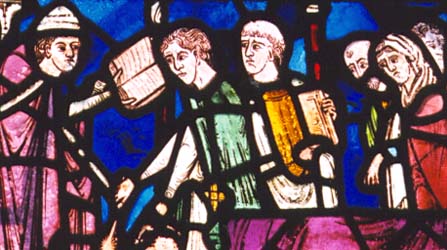
While some townspeople may have shaped their devotion
to the Church to suit their own interests, it is hard to discount the
effect on attitudes and behaviours of the belief – so strongly
promoted by Catholicism – of an all-seeing, all-knowing God, who
would consign souls to Heaven or Hell, based on earthly performance.
(click on the image for an enlarged version and more
information)
BARROW, Julia. "Churches, education and literacy in towns 600-1300." Pp.127-152 in The Cambridge Urban History of Britain, vol.1, ed. D.M. Palliser. Cambridge: University Press, 2000.
BURGESS, Clive. "'By Quick and by Dead': wills and pious provision in late medieval Bristol." English Historical Review, vol.405 (October 1987), 837-58.
CATHOLIC ENCYCLOPEDIA - "Hospitals"
http://www.newadvent.org/cathen/07480a.htm
DOBSON, Barrie. "Mendicant Ideal and Practice in Late Medieval York." Pp.109-22 in Archaeological Papers from York Presented to M.W. Barley, ed. P.V. Addyman and V.E. Black. York: York Archaeological Trust, 1984.
FINCH, Andrew, ed. "Heresy". Part of Virtual Norfolk: Norfolk
History Online.
http://www.webarchive.org.uk/wayback/archive/20050606184058/http://virtualnorfolk.uea.ac.uk/heresy/index.html
GODFREY, Walter H. The English Almshouse. London: Faber and Faber, 1955.
GRANSHAW, Lindsay and Roy PORTER, eds. The Hospital in History. London: Routledge, 1989.
MARTIN, G.H. "Church life in medieval Leicester." Pp. 27-37 in The growth of Leicester, Leicester: University Press, 1970.
ORME, Nicholas and Margaret WEBSTER. The English Hospital, 1070-1570. New Haven: Yale University Press, 1995.
PLATT, Colin. The Parish Churches of Medieval England. London: Secker & Warburg, 1981.
POSTLES, Dave. Some Ambiguities of Late Medieval Religion in
England. Institute of Historical Research Electronic Seminars
in History.
http://www.history.ac.uk/resources/e-seminars/postles-paper
RAWCLIFFE, Carole. The Hospitals of Medieval Norwich. Studies in East Anglian History, no.2. Norwich: University of East Anglia, 1995.
RUBIN, Miri. Charity and Community in Medieval Cambridge. Cambridge: University Press, 1987.
TANNER, Norman. The Church in Late Medieval Norwich, 1370-1532. Toronto: Pontifical Institute of Mediaeval Studies, 1984.
THOMSON, John. The Later Lollards, 1414-1520. Oxford: University Press, 1965.
|
|
 main menu |
|
|
||